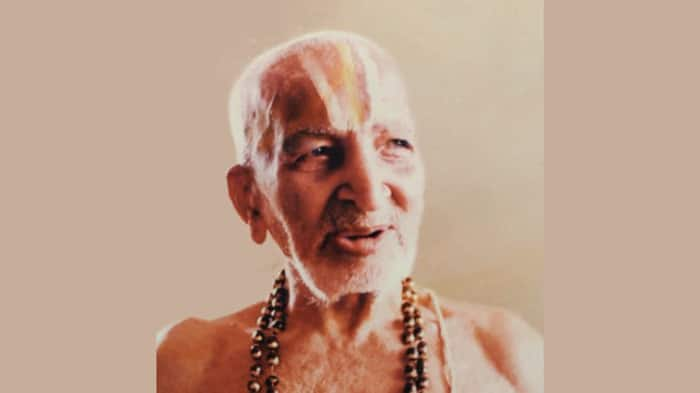
By clicking “Accept All Cookies”, you agree to the storing of cookies on your device to enhance site navigation, analyze site usage, and assist in our marketing efforts Cookies Policy.

“Citti Vritti Nirodha – When the mind is without any movement for a quarter of an hour or even quarter of a minute, you will realize that yoga is of the nature of infinite awareness, infinite knowing. There is no other object there.” This is one of his fundamental teachings of T. Krishnamacharya. Here, he refers to a state of Samadhi (The pinnacle of sustained mental focus), which could be achieved by the asanas.
Tirumalai Krishnamacharya, is the man whose name has become synonymous with yoga in the modern era. Krishnamacharya made the world became aware of Yoga. He gave it the contemporary edge and popularized it throughout the world. He lived until the age of 101 and remained to be a dedicated and enthusiastic teacher till his death. His ability to combine thorough knowledge of yoga and other ancient Indian philosophies, with the values of the 20th century gave him international recognition. He questioned the rigid practices that existed at that time and put his best foot forward in growing above the backward practices in the society.
He was the first one to teach women yoga. His sister, wife and daughters were equipped with the knowledge of yoga. This was primarily because he considered yoga as a path to devotion and wisdom and not merely a physical exercise. This novel approach towards health, religion and philosophy attracted the west towards Krishnamacharya’s modern yoga. Krishnamacharya’s teachings included three main aspects- Pranayama preceded by Mudras and Asanas. With increasing popularity of yoga, kings at that time also wanted to learn the yoga lessons.
In 1930’s Krishnamacharya demonstrated his ability to stop the heartbeat. Physicians present at the time could not hear his heart beating for more than a minute. In 1970 when an interviewer asked him how he could achieve that, he responded by saying, “all that happened automatically. What is amazing in that? I did it by practicing pranayama, vishama vrtti in nadishodhana pranayama. And meditation as well.” This was the caliber and dedication of Krishnamacharya.
One of his basic principles was to “teach what is appropriate to each individual.” He taught jumping asanas to his kids at the age of seven and eight and to his wife, although he did not teach her the asanas that involved back bending. Along with being a classic yoga practitioner he had also studied Vedic texts, Sankhya philosophy, Sanskrit, logic and grammar at Mysore and Banaras Universities. At the age of 28 he walked two hundred and eleven miles to Manasasarovar Lake in Tibet, where he met his yoga guru Shri Ramamohan Bhrahmachari. He lived and studied yoga with his guru for eight years.
Krishnamacharya was an ocean of knowledge and this helped him analyzing the yoga asanas and molding them as per the requirements of each individual’s health and age. Along with philosophy he was also educated about the science of body’s structure and Ayurveda. The reason behind the international popularity of Krishnamacharya, is due to the fact that he never mixed religion and yoga. His broad-mindedness and liberal approach appealed to westerners. He has authored four books on Yoga, “Yoga Makaranda,” “Yogaasangalu,” “Yoga Rahasya” and “Yogavalli.”
If you have ever taken a yoga class- you know what inhale and exhale is all about. It means synchronizing your breath with a series of progressive postures. Krishnamacharya believed that yoga was the unification of mind, body and soul. This practice of yoga produces intense internal heat and abundant, purifying sweat that detoxifies the muscles and organs. This results in improved circulation, a light and strong body and a calm mind. This form of yoga is perfectly suitable for the modern lifestyle. As per the Centers for Disease Control and Prevention, about one of three (67 million people) US adults have high blood pressure. Only about half (47 percent) of these people have their high blood pressure under control. Krishnamacharya was indeed a true visionary, because he could sense the need for such asanas in the 18th century.
Raja Yoga is the practice of training your mind to focus at one point and Hatha yoga mainly involved asanas with physical exercises. Krishnamacharya combined both these practices into one. His asanas involved physical exercises as concentrating on your breath which helped improve concentration and improved the overall health.
A long with being a progressive yoga practitioner Krishnamacharya was also known as a exceptional healer who borrowed the Ayurvedic knowledge and yogic traditions.
An article published on Yogajournal.com talks about a study conducted in 2012 about the Yoga in America says indicated that 8.7 percent of U.S. adults, or 20.4 million people, practice yoga. Of current non-practitioners, 44.4 percent of Americans call themselves “aspirational yogis”— people who are interested in trying yoga.”
Krishnamacharya was a true visionary, as he could sense the need for the practice of Yoga for generations to come. Yoga is definitely the most relevant physical and mental healing exercise. So, are you eager to learn Yoga? There are plenty yoga classes in most US cities now, go ahead and begin your yogic journey!
For breaking news and live news updates, like us on Facebook or follow us on Twitter and Instagram. Read more on Latest Health News on India.com.